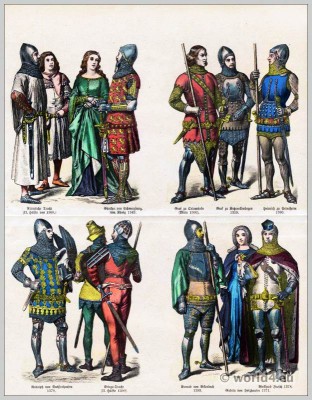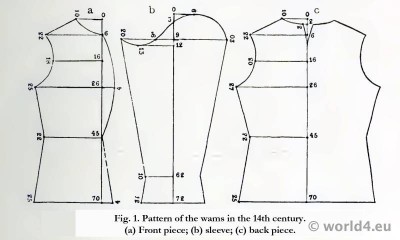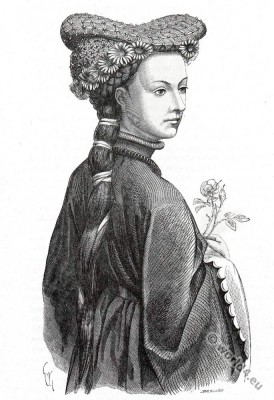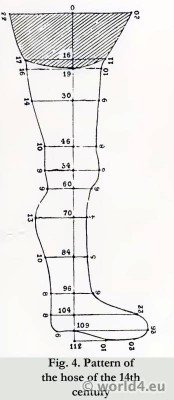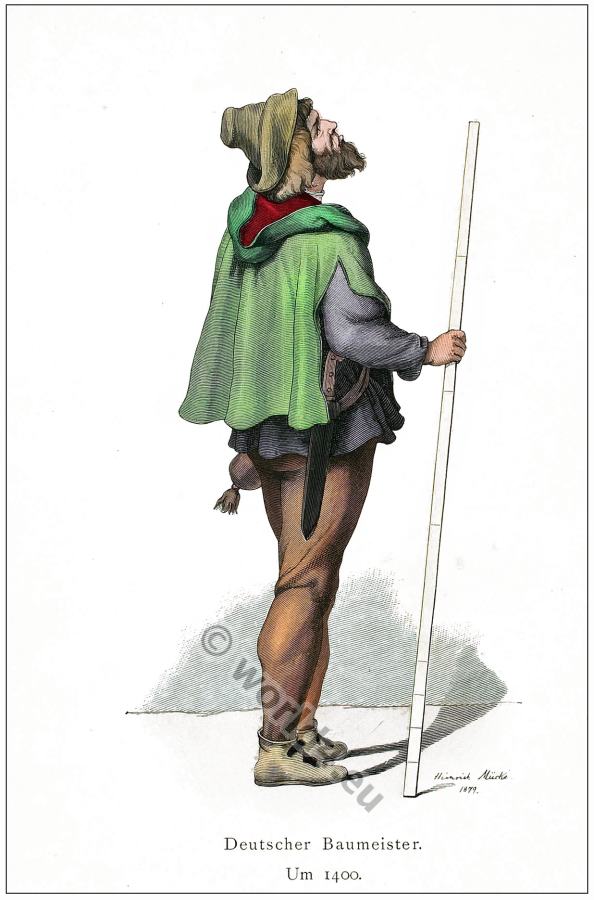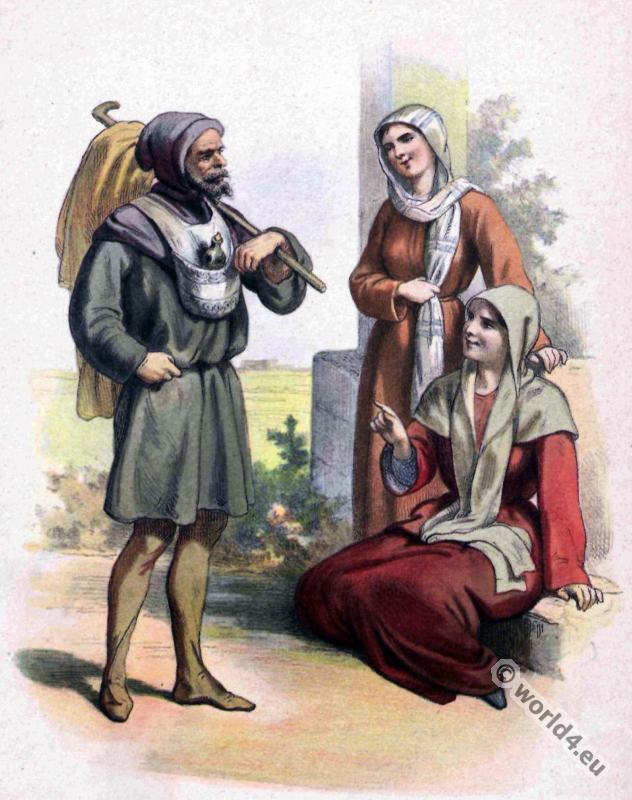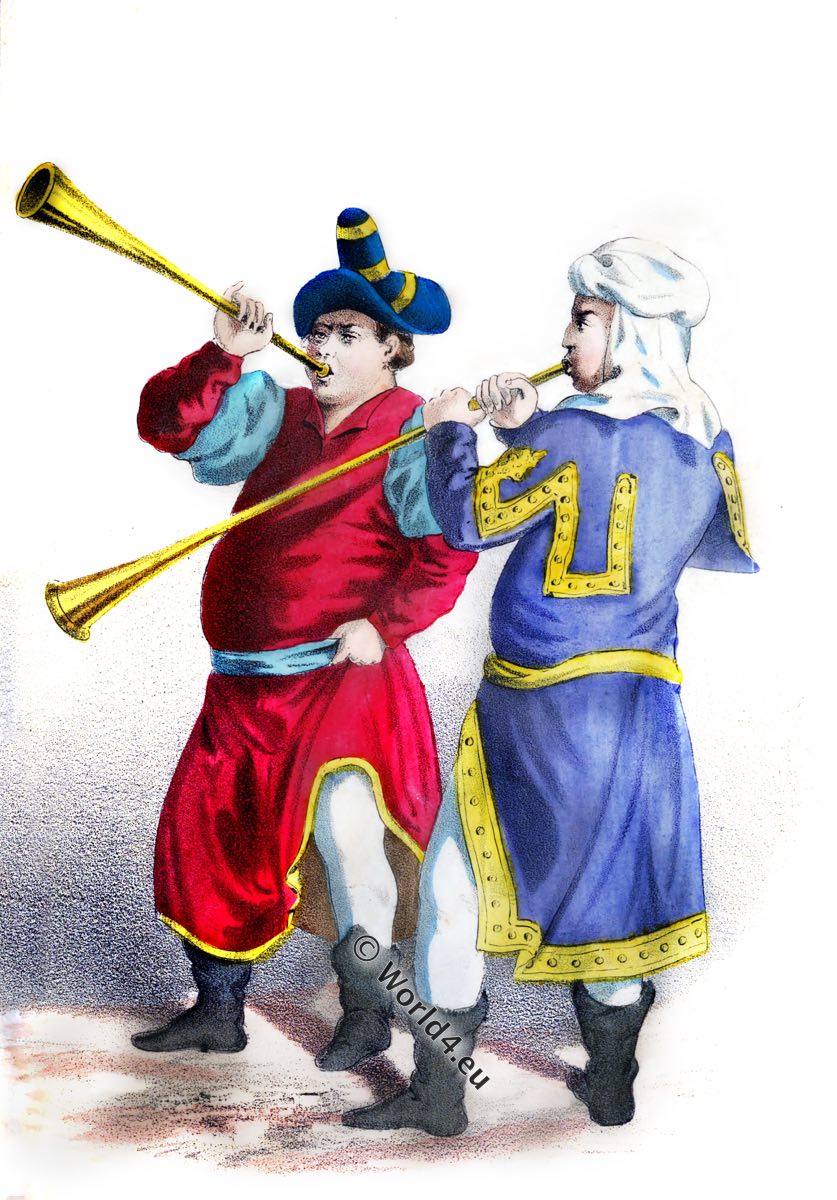German medieval clothing 14th century
Medieval, Byzantine, Burgundy, Gothic era.
Top row left to right: German princes and knight. Right: A German princess and precious lady in court costume.
Bottom row left to right: Knight and unmarried noblewomen. Right: Wealthy German patricians.
Source: On the history of costumes. Münchener Bilderbogen. Edited by Braun and Schneider 1860.
Men’s Dress 14th century
During the fourteenth century the war dress of the knightly orders in Germany underwent the same transformation as in France. The German knights, like the French, began to have their tunics made shorter and closer-fitting, as well as open in front, and sometimes also at the sides almost up to the hips.
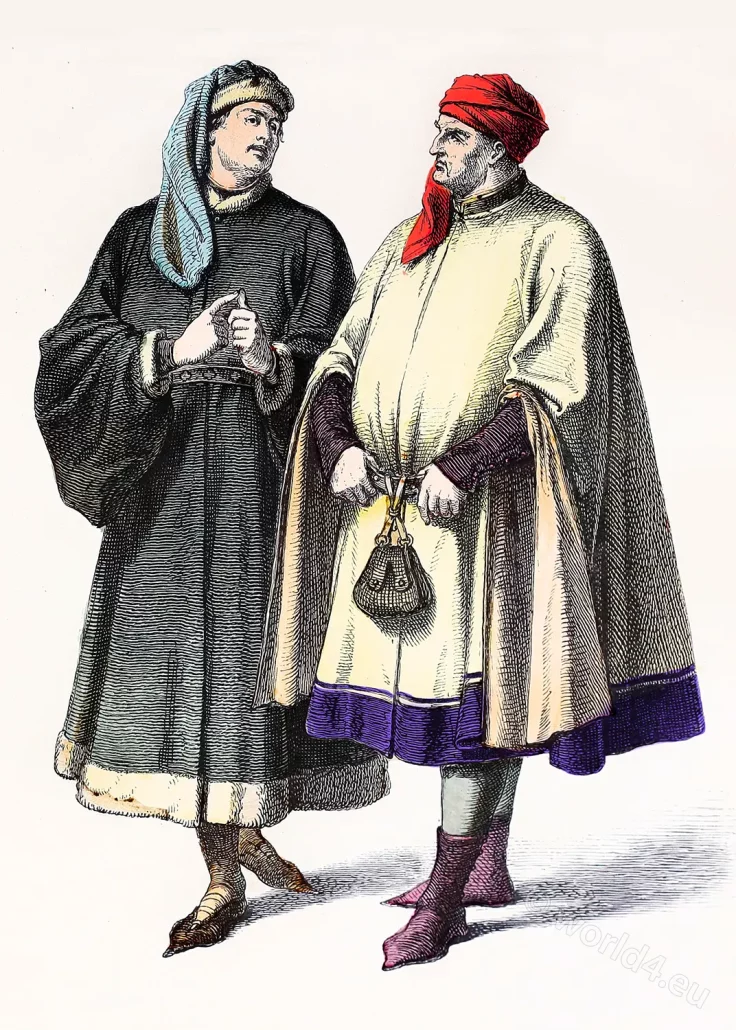
The material of these tunics, which reached to the knees, was in most cases cloth, but they were frequently made of velvet or silk or other material, lined with fur, and embroidered with the coat of arms of the wearer. The tunic was held in place by a richly ornamented waist-belt, which was buckled loosely. This belt also served to hold the knight’s sword on the right side and on the left side his dagger. These were attached to the belt by special thongs.
In the second half of the century the tunic had become still shorter and closer-fitting, until finally it was very tight and hardly covered the trunk; the belt encircled the body below the hips. These tight tunics were called Lendener. They were made of very thick but pliant leather, and were sometimes sleeveless.
Usually, however, they had short sleeves, which were laced or buttoned in front or at the side or behind. The Lendener was magnificently trimmed. It was usually dyed the color of the wearer’s scutcheon. His crest was painted on it, or it was covered with dyed velvet on which the crest was embroidered. The breast of the tunic was decorated with metal rosettes from which gilt chains depended.
To these were attached the knight’s helmet, sword, and dagger, so that they could not be lost in the field. Beneath the tunic the knight wore a suit of chain mail that covered the whole person; it was strengthened at the arms and legs by leather straps and joint-pieces of iron. The knight’s chief defensive armor was his thick, padded coat of leather worn beneath the mail shirt.
This leather coat, the Wammes (The name Wammes instead of Rock (coat) was used by the Germans long before the fourteenth century, and it is quite possible that the French and the English borrowed from the Germans their almost homonymous names for the leather coat worn beneath armor.), in England called gambeson, and by the French gambesson, was the knight’s indoor dress. (See Fig. 1.)

It resembled the usual male coat of the day as well as the Lendener, except that, as already mentioned, this last was either sleeveless or had very short sleeves and, as it was worn above the Wams (or, in later English, doublet) and the mail, was much wider.
The Wams had always long, tight sleeves. It was open all down the front, and could either be laced or buttoned (Fig. 2.). It was also open at the sides from the hips downward, and there too it could be buttoned. If it was to be used merely as an indoor dress, it was longer than when it was to be worn under mail. In that case, too, it was padded only slightly or not at all.
The material of which this doublet (Wams) was made varied greatly. It was mostly of leather or of coarse or fine cloth, but sometimes it was of silk or velvet. It was never trimmed or embroidered in any way.
Over the doublet a longish over-garment was often put on. This was worn, however, only during the first decade of the fourteenth century; it was worn with the usual long, wide under-clothes. Later, like the Wams, it became much tighter and shorter.
About the middle of the fourteenth century this over-garment had lost so much of its earlier fullness that it diftered from the Wams only in its greater length and its shorter sleeves. This greater length made inevitable, of course, a much greater width below, because the width gradually increased from the hips down.
The garment was closed in front. The equally tight sleeves of a similar over-garment did not come quite down to the elbow in front, but a considerable piece of the sleeve hung down behind the elbow. This pendent piece was sometimes extremely long, and was frequently lined with silk or fur.
The cloak, Heuke or Henke, was not so often worn as in the fourteenth century. It still retained its earlier semicircular shape, and was gathered at the shoulder and fixed at first with a clasp and later by several buttons. (See Fig. 3.) It was no longer worn with the centre over the nape of the neck, but was put on so as to hang lower on the left side than on the right. It could be shortened by being raised with the left arm.
Besides these open cloaks, cloaks closed all round were worn, as well as cloaks which could be buttoned from top to bottom in front. These varied in length. They were called Glocken (bells), and were almost circular in cut.
The commonest form of leg-wear in the fourteenth century was still long hose. Like long stockings, they had feet, and covered the whole of the leg (Fig. 4.). They were kept up by being attached at the top to a belt which was buckled round the body beneath the coat. These hose were as tight as possible; they were sometimes of leather and sometimes of elastic material like wool. Those made of cloth had either one or two seams. The material was cut exactly in the shape of the leg, and was sewn either up the back only or at both back and front. The legs were often of different colors.
Toward the end of the fourteenth century tailors began to make hose of elastic material (A material of this kind was Scharlach (scarlet), made of the finest wool, which was in great favor both with knights and rich citizens and which, owing to its great elasticity, was a more suitable material for hose than any other. The commonest colors of Scharlach were red and brown, but it was also obtainable in green, blue, or white.
Probably the name of the material was afterward transferred to its color.), and to sew them together so that the combined hose made a garment that covered not only the legs, but the lower body. If the hose were made of inelastic material, the side-flaps with which the hose were fastened to the waist-belt were as broad as the material allowed, so as to cover the body completely front and back. If the hose were joined only at the back, the feet were made separately and attached afterward.

The most usual form of headdress was the hood, variously called Gugel, Kogel, or Kugel, but it was worn only in rough weather. At other times it was allowed to hang down the back.
These hoods varied greatly both in size and shape. Some were made with one seam in the front; some with two seams, back and front. Sometimes the Gugel fitted closely round the head ; sometimes it was looser, and sometimes it reached down to the shoulders or encircled the body collar-wise, coming down almost to the elbows. It was either closed all round or made to be buttoned in front. These were the so-called geknäuften Kogeln (buttoned hoods). The hood had tips of varying length; toward the end of the century it was often so long that it hung down as far as the calf of the leg, like a thin, stuffed tail. About the same time the edge of the Gugel was cut into points or trimmed with material of a different color.
These hoods were made of cloth or of soft, pliant leather, often dyed. They were lined with fur, adorned with erect plumes, and trimmed round the edge with numerous small pendent metal bugles.
The usual footwear consisted of ankle-shoes enclosing the entire foot, but low shoes with long, pointed toes were also worn. These were fastened over the instep by clasps. In addition to these a tall kind of boot was worn. During the second half of the fourteenth century boots and shoes were often dispensed with, being replaced by leather soles on the hose.
Women’s Dress, 14th century.
Changes in women’s dress were chiefly at the neck and hips and sleeves. The under-dress was now somewhat low. It was laced in front or at the side—more rarely at the back—and fitted very closely all the way from the shoulders to far below the hips. From the hip-joint down it was gradually widened by the insertion of gussets at the back and side seams. It was of the same length all round, and was so long that the wearer had to raise it in front in order to be able to walk. The sleeves were tight from sleeve-hole to wrist, and were trimmed with small buttons at the back and from the wrist to the elbow.
The sleeves were sometimes so long that they came half-way down the hand. Both dress and sleeves were still made in the old way—i.e., back and front were sewn together only on the shoulders and down the sides, while the sleeves were straight and had only one seam, down the back. (See Fig. 214.)
The over-dress had the same shape as the one worn beneath it, and, except that it was made of more expensive material, differed from it only by having shorter sleeves (Fig. 215). These short sleeves were also as tight as possible; in front they came only to the elbow, whereas the back of the sleeve fell in a long strip to the knee. The width of this strip was usually half that of the sleeve.
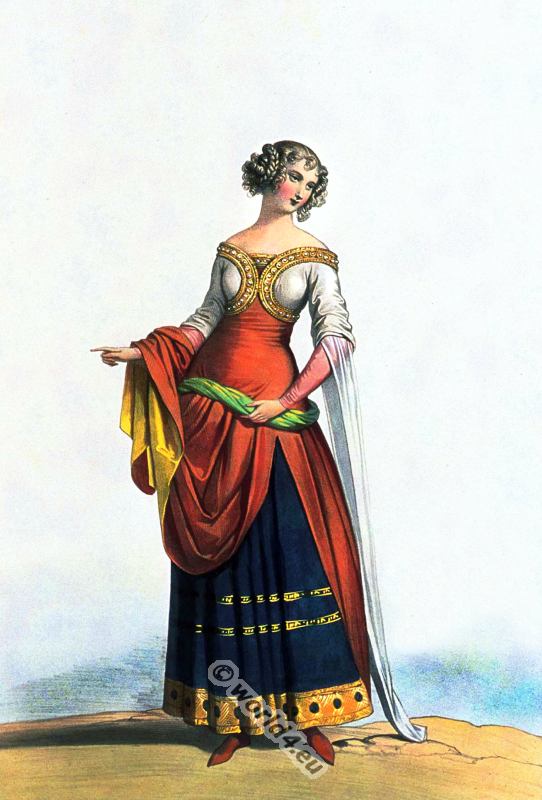
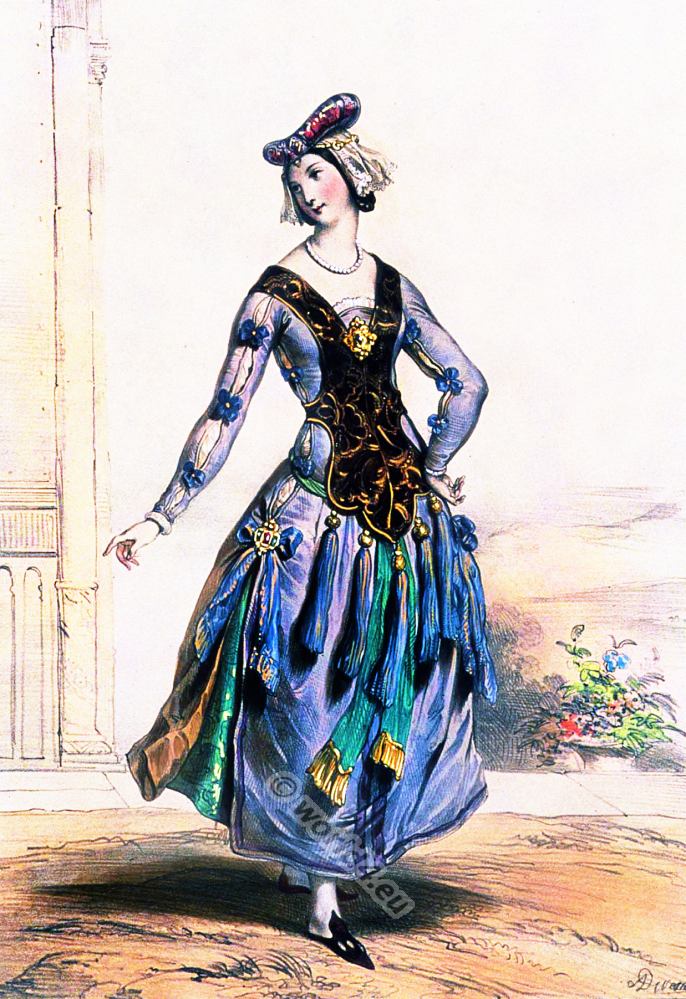
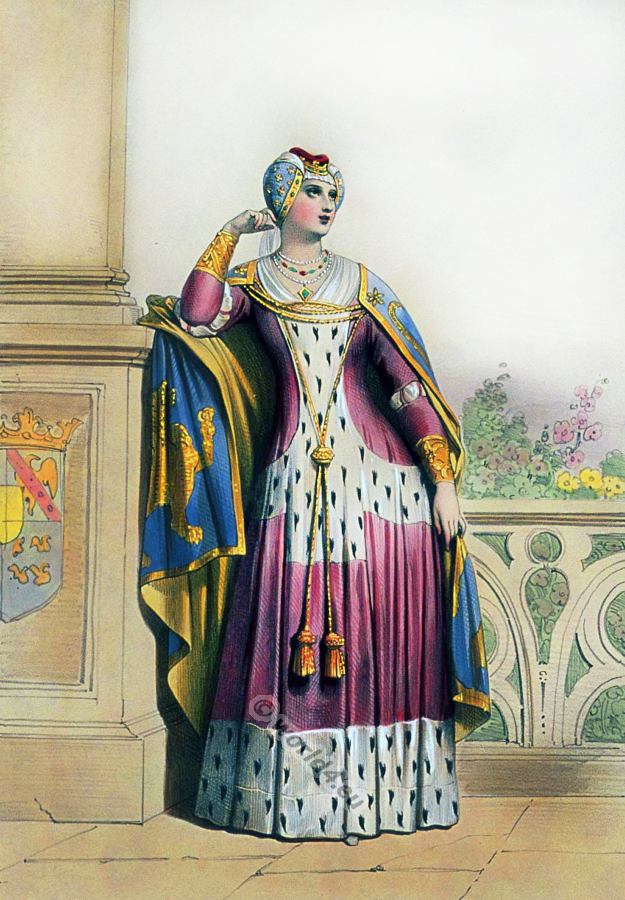
Another over-dress popular in Germany was the Sorket. It had no sleeves, and was cut away at both sides from shoulders to hips. Its name clearly betrays its French origin, and it exactly resembled its prototype the French surcot.
This dress, which went entirely out of fashion during the second half of the century, was trimmed in accordance with English ideas. The Limburger Chronik tells us: ” The over-dress was called Sorket. At both sides and at the foot it was slashed and trimmed, in winter with fur and in summer with silk, so that it was suitable for any lady at any time.” If German women, like Frenchwomen, had had the upper part of the Sorket made entirely of fur the Chronik would certainly have mentioned it, or some mention of the fact would be found in the literature of the subject.
Source: A History of costume by Carl Koehler. Edited and augmented by Emma von Sichart. Translated by Alexander k. Dallas M.A. Lecturer in German In Heriot-Watt College Edinburgh.
Discover more from World4 Costume Culture History
Subscribe to get the latest posts sent to your email.


